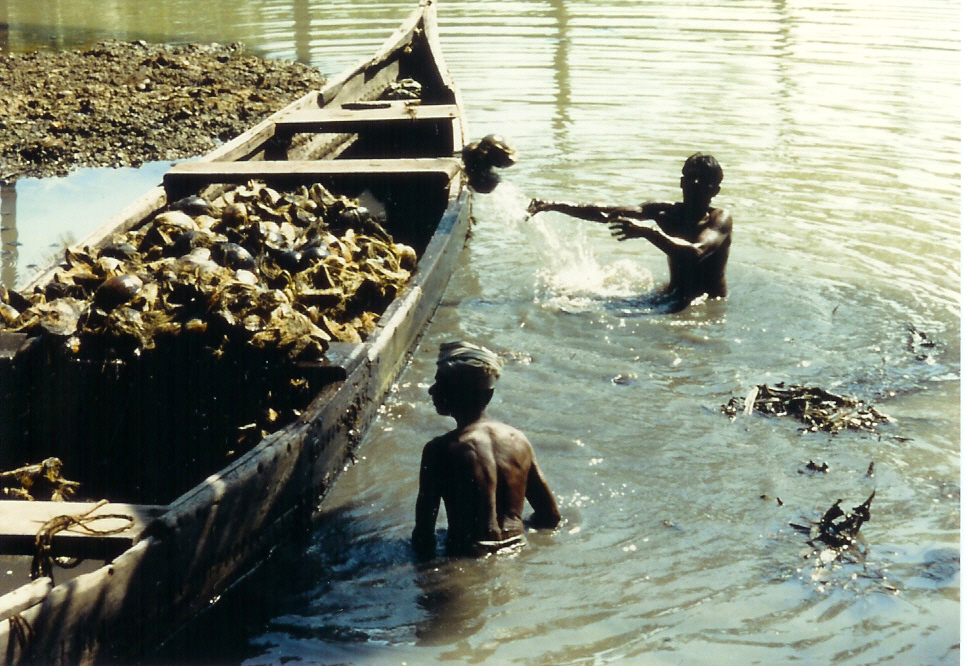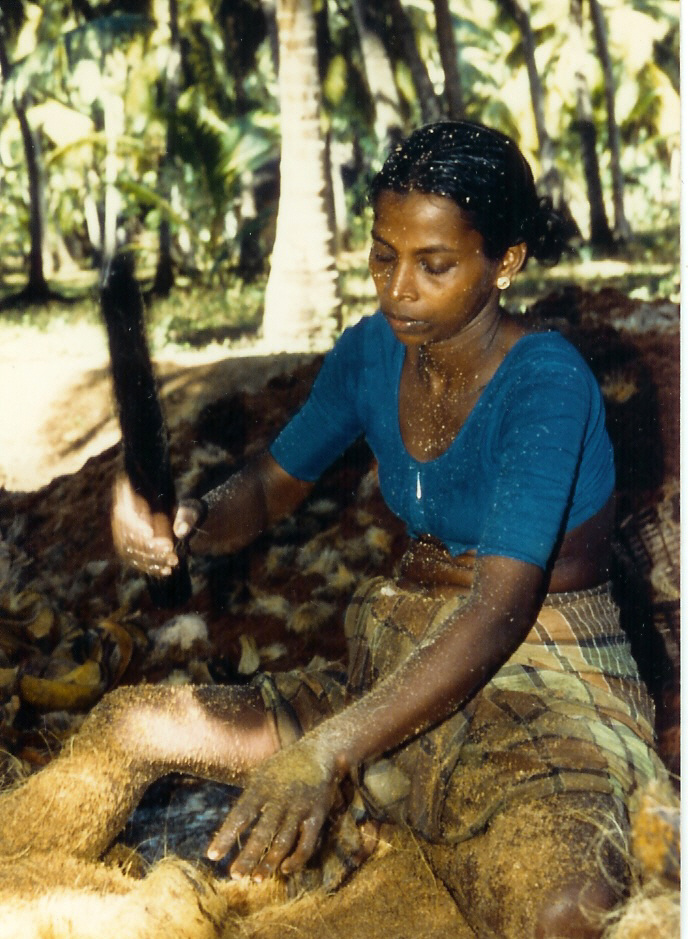|
Global Exchange Kerala Reality Tour GX Tour Itinerary Page Coir: From Coconut Shell to Doormat Coir (pronounced "Kai-yer") is one of Kerala's most important products.
Coir is a natural fiber that helps hold together the coconut shell. When
extracted, it can be spun into one of the world's strongest threads and woven
into mats and baskets of all kinds. Coir mats with US football
team logos photographed in Kerala. The mats sell in the In most coconut producing countries the main coconut product is
"copra," the coconut meat. The husks are burned as fuel, used as
manure, or discarded. In Kerala and the Coconut The coconut tree is known to Malayalees – the people of Kerala – as
"kalpaverksham," (the tree of all uses). A few trees on a small
plot will yield enough materials and income to make them desirable to even
the poorest household. The coconut (called "tengga" in Kerala)
provides a soothing drink, a nutritional food, a delicious cooking oil that
can also light the vilaku or religious lamp, leaves to make the roof
of a house, twigs and branches to cook in the family stove, and from the
initial flower stem a sap from which a mineral rich and mildly alcoholic
drink called "toddy" self-ferments. The sap can also be distilled
into arrack, a stronger alcoholic concoction or cooked down to
jaggary, coconut palm sugar similar to American brown sugar. In recent years
thousands of acres of rice fields and other lands A coconut retting pile near Anjengo, Kerala Making
White Coir: Along with the products mentioned above, the coconut shells offer
materials for handicrafts and for coir. The first step in making coir is to
"ret," or rot the coconut shells by immersing them in water for
nine months. The shells are piled in a salt water back area about 4 feet deep
and covered with mud. Men do this work during the agricultural off-season in
Kerala's lowland regions. After nine months, the husks are removed from the
retting mound, loaded into canoes, and taken to the threshing compounds. Pulling Up the
Rotted Shells The retted husks are then pounded and crushed by mostly young women with mallets or machetes who then pull off and collect the fibers. This is some of the hardest and lowest paid wage work in Kerala.
Baskets filled with the threshed and dried fiber are shipped to nearby spinning sheds where an all-female workforce hand spins the two inch long pieces into strings of yarn up to 60 feet long. This is accomplished by having a spinner at a wheel to which is attached a gear with a small spinning axel. The women spinners stand two at each wheel and each wheel has two gears. Each woman attaches a handful of fibers from her basket to each of the two gear ends; the spinner starts to spin; and the women walk backwards swiftly, pulling fibers from their baskets to attach deftly to the spinning and lengthening yarn. After walking backwards for about 30 feet, each woman begins to lace together the two strands as she walks forward towards the spinner, creating a stronger yarn strand. After approaching the wheel, she pulls off her newly created thread and hangs it on a nearby wall, then runs a few fibers around the axel to start over. Spinners rarely make more than $1.00 per day, though they run backwards for up to 15 km. when the day’s work is added up.
From coconut fiber to coir
yarn. Spinners at work. No electricity is used and the only equipment is the
hand cranked spinning device at front of the photo. Long strands of the coir rope are sometimes rewound into heavy rope. This
has been used for about the last 200 years to tie ships at the docks. Coir
rope competes with sisal (coming mostly from Other strands are made into baskets, but jute that is produced in Coir yarn can be woven into high quality and attractive mats, however. The
coir industry in coastal Kerala goes back to the mid-Nineteenth Century when
a British businessman named William Goodacre set up a coir
Weaving is the most skilled part of the production process. It is done mostly by men and the pay is somewhat higher than for other parts of the production process. A skilled weaver could earn about Rs 115 per day, about $2.40 in 2002. But most weavers have difficulty finding more than 20 days work per month, so effective wages are $1.80, or 25% below the desired level since workers expect a six day week. Many would work seven days to support their families. All the workers in the coir production process tend to live below the local poverty line, except for some whose children have managed to get better paying public service sector jobs such as teaching, or a few who have been able to become tailors. Sources: Thomas Isaac, T. M., P. A. Van
Stuijvenberg, and K. N. Nair. 1992. Modernisation
and Employment: The Coir Industry in Kerala. |
|
|

 have
been converted to coconut groves in Kerala.
have
been converted to coconut groves in Kerala.


 production
and trading business in Aleppey, Kerala. The company still exists and has his
name, but is now owned by an Indian entrepreneur.
production
and trading business in Aleppey, Kerala. The company still exists and has his
name, but is now owned by an Indian entrepreneur.